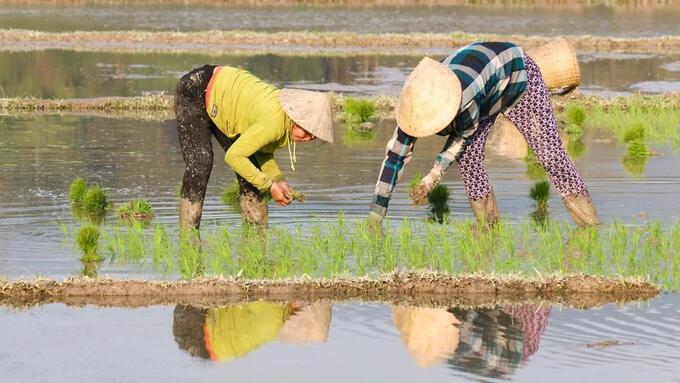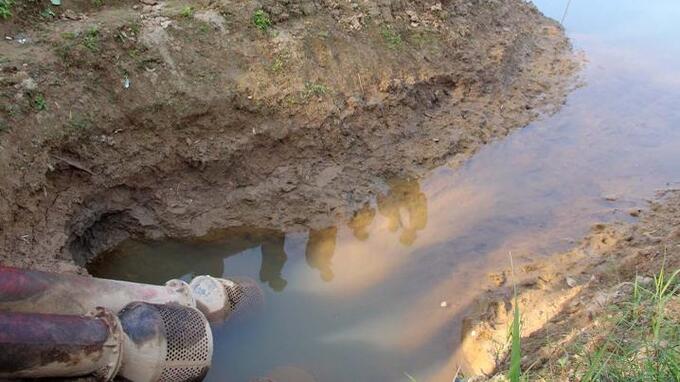In the spring rice harvest of 2023, Nghe An planted 91,000 ha and aimed for an average rice yield of 67.2 quintals/ha with a production of 611,500 tons.
In order to achieve the above rice yield, in addition to the appropriate seed structure, heavy investment in intensive agriculture, timely pest and disease prevention, etc., sowing timing is ensured according to the seasonal schedule issued by agriculture. crucial to the success of this spring rice crop.
By Feb. 8, Nghe An had basically completed the plan to plant 91,000 ha of spring rice, leaving only a small number of planting areas slowed down and not operating due to the dried up Lam River, electric pumping stations in Thanh Chuong and Do Luong districts The problem will soon be resolved when the Ban Ve Hydroelectric Power Plant discharges water in an amount large enough to raise the water level of the Lam River to allow electric pumping stations on both banks of the Lam River to operate again.

As of February 8, Nghe An had essentially closed the planting area as planned. Picture: Dinh Tuan.
Lock down the area according to the seasonal schedule
As mentioned, right after the Lunar New Year, from the morning of January 25 (the 4th day of the Lunar New Year), all the fields in Nghe An Province were full of people going to the fields to plant rice to ensure the right schedule . The season is determined by the province’s agriculture at the beginning of the season.
Mr. Pham Van Bay of Hamlet 2, Dien Lien Township, Dien Chau District, said his family planted 2 ha of rice this spring, the most in the municipality and perhaps the most in the district. When asked why his family has such a large rice area, he said: there are some families with many fields, anchor people, their children go to work far away, cannot farm the whole land, he asked them to give up. to plant again.
After 3 happy spring days to welcome Tet, starting the morning of the 4th day of the lunar new year (February 25th), his whole family and a bunch of planters were hired by him to help go without lunch all day plant, eat on the farm paddy field. With these efforts, his family finished planting 2 hectares of rice in just 6 days to ensure the seasonal schedule announced daily through the municipality’s loudspeakers by the Department of Agriculture and Rural Development of the district and the municipality.
Mr. Vo Van Giap, Director of Dien Lien Agricultural Cooperative said, For this year’s spring rice harvest, the cooperative has planted 320 ha of rice. Of these, 225 hectares are planted with Japanese HD9 and Cozi strains produced and sold by Cuong Tan Seed Joint Stock Company (Nam Dinh). The requirements for the production of the above two types of rice are quite strict from sowing, transplanting, seasonality, intensive farming… But it’s not difficult if people are trained to tell them why they need to do it will be high productivity, people will listen, will exactly meet the technical requirements. In this way, in just 6-7 days, from January 25th to January 31st, the entire cooperative planted 320 ha of rice, guaranteeing the established seasonal plan.

Nghe An farmers go to the fields right after 3 days of Tet to complete the planting plan. Picture: Dinh Tuan.
Dien Chau District Agriculture and Rural Development Department Chief Mr. Le The Hieu said: In this year’s spring rice harvest, after 3 days of Tet holiday, the entire district planted 9,000 hectares of rice from the morning of the 4th day of Tet, farmers in all the communities in the district have all gone to the fields to plant rice. There are many communes like Dien Nguyen, Dien Thai, Dien Cat… who also go to the fields to plant rice before the 4th Tet day. Up to now, the entire district has finished planting the entire area of spring rice, which is out of the planned area, by the prescribed time.
In Yen Thanh district, this is the district with the spring rice cultivation area of up to 12,800 ha, the largest in the province. According to Mr. Le Van Hong, head of the Department of Agriculture and Rural Development of the district, said: Before the Lunar New Year, a number of communities in low-lying areas such as Long Thanh, Vinh Thanh, Nhan Thanh, Vien Thanh, Khanh Thanh… had harvested 3-5 days earlier than other communities in the district.
Because this land is deep and muddy, it often takes longer for rice plants to grow than other highland areas, so farmers have to plant earlier to harvest early and plant the summer-autumn rice. After learning from previous spring rice harvests, this year’s spring rice harvest directly from the implementation of the production project, the Yen Thanh District People’s Committee has tasked the community people’s committees to strictly guide the planting season schedule, while assigning district officials to closely follow the communities to monitor and inspect the implementation of the spring grain production project in each production facility.
After the 3rd day of the lunar new year, farmers in the district’s communities simultaneously went to the fields to plant rice, with the spirit of urgency, determined to plant all areas according to the seasonal schedule. With this action and the determination of the farmers in the district, the entire district had planted 12,800 hectares of rice as planned by February 6th.

Farmers in Nam Dan district fertilize manure for newly seeded spring rice. Picture: Phu Huong.
Not only in the lowland districts, the planting of this spring rice crop is basically complete, in the mountainous regions, this year’s spring rice crop is no longer frozen because it is covered with plastic and most of the production facilities. The farmers have been going to the fields to plant rice since the 4th day of the Lunar New Year and after only 4-5 days, the mountain districts are done sowing.
Mr. Le Kham Kha, head of the Ministry of Agriculture and Rural Development of Tuong Duong District, said, “In our mountainous district, the area of wet rice sown in the spring harvest is not large, only 960 ha. Therefore, we guide the farmers sow according to the prescribed seasonal schedule , the seed is covered with nylon, the whole field is plowed and harrowed, fully fertilized, and from the 4th day of the lunar new year, all farmers go to the fields to plant rice. By January 10 (January 31), the entire Planted 960 ha of rice area of the district.
Beware of upcoming downsides
It is difficult to predict whether the weather trends will be favorable or unfavorable for this year’s spring rice harvest in the upcoming period. But according to the forecast of the hydrometeorology industry and many experts in the agribusiness, this year’s spring rice harvest could have three adverse possibilities:
The first: Also in the coming period, the weather trend will continue from cloudy days with a lot of fog in the mornings to sunny afternoons and afternoons, the air temperature will gradually warm up. This weather trend will create favorable conditions for the blast fungus to emerge and damage rice. Especially the coastal plains, the plains surrounded by high mountains, are prone to large-scale blast disease. Therefore, after sowing, it is necessary to visit the fields regularly for early detection of pathogens on rice leaves to prevent them once new diseases appear, according to the instructions of the Provincial Ministry of Cultivation and Plant Protection and the city’s agricultural service centers.

The low water level of the Lam River has made it difficult in some places in Nghe An to get water locally for this year’s spring harvest.
Monday: From the end of 2022 until now, there has been little rain, the flow of water in rivers, streams and dams has gradually dried up. In particular, the water level in the Lam, Hieu, Con, … rivers went dry, electric pumping stations along the Lam river in Thanh Chuong, Do Luong districts … could not continue to operate, not even in lowland areas of the Lam, Bung rivers and Hoang Mai will rise salt water if there is no heavy rains in the coming period.
Therefore, the communities, especially the water points of lakes, dams and electric pumping stations in the above rivers, must have plans to store water in fields, in ditches, in ponds and lakes and to use water really sparingly. At the same time, before pumping water, it is necessary to check whether the salinity of the water is allowed to be pumped or not, to avoid rice dying after pumping because the water is too salty.
Tuesday: It is likely that next time the weather trend will continue to be warm and sunny, and the air temperature will rise rapidly. In this case, there will be a number of short-term rice varieties in some places, flowering early on Tiet Thanh Minh due to unintentional or intentional early sowing, 7-10 days before the set seasonal schedule, and prone to cold due to the cold air at the end of the season, which severely affects the yield.
Therefore, farmers in this field need to actively drain the dry water, dry the fields repeatedly, repeat twice, each time for 3-5 days, to prevent the rice from growing too fast due to the high temperature. If conditions permit, mulching around the rice root can also limit rice cultivation and early flowering to 3-4 days.

